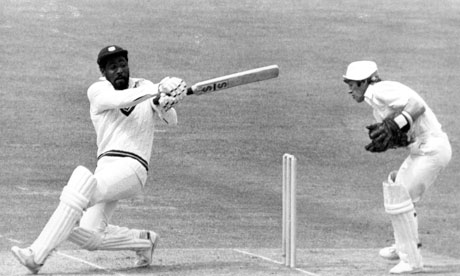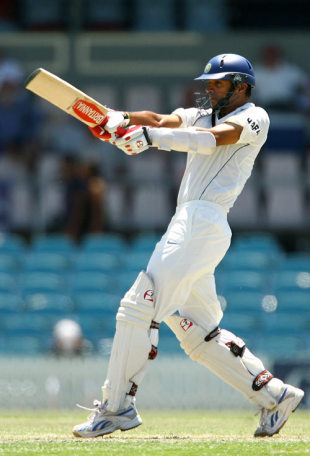Will Rhodes on Good Length for a bowler
A good length is the shortest length where a batsman is obliged to play forward.
The Right Speed is when a batsman beaten by flight does not have the time to play a second shot.
Musa Okwonga: The annual Wimbledon conundrum
The Independent
It's nerve; it's grit; it's the key ingredient that makes a true champion. As Andy Murray aims to break his Grand Slam duck, our writer gets to the root of what every winner needs
Sunday, 26 June 2011
Bottle. It's an odd word to describe the spirit that all athletes need when faced with unprecedented pressure, but it somehow seems to have stuck. There are several conflicting and convoluted suggestions as to its origin: the most recurrent is that "bottle" is derived from Cockney rhyming slang, "bottle and glass". If you've got plenty of "bottle and glass", so the slang goes, then that means that you've got plenty of "arse" when you're confronted with a career-defining test.
Bottle isn't like muscle: it's not visible to the naked eye. At first glance, most of the world's leading sportsmen and sportswomen look routinely impressive: fit, focused, intimidatingly intense. It's only when they're stepping towards that penalty spot or standing at that free-throw line that we get to peer beneath the veneer – to glance at the self-doubt that threatens to engulf them. And engulf them it does, time and again. Just look at Jana Novotna in the 1993 Wimbledon singles final, when she had a game point to go up 5-1 in the final set against Steffi Graf. Until that moment, we didn't know that Novotna would fold; maybe she didn't know, either. But a few games later, she was sobbing on the shoulder of the Duchess of Kent as Graf took the title.
We don't have to look beyond our shores to find ample examples of those who've bottled it. In football, there's the familiar litany of losses to Germany; to name but one, the 1990 World Cup, where England's Stuart Pearce hit his spot-kick into the goalkeeper's midriff and Chris Waddle sliced his high over the crossbar. More recently, in golf, and the sight of Rory McIlroy's surrender at Augusta in the 2011 Masters was especially spectacular. Leading by four shots heading into the final round, holding a one-shot advantage as he moved into the back nine, he then dropped six shots in three holes, finishing 10 shots behind the leader Charl Schwartzel and recording an eight-over-par score of 80.
However, McIlroy's reaction to his meltdown said much about his character, and about the nature of bottle. "Well that wasn't the plan!" he tweeted. "But you have to lose before you can win. This day will make me stronger in the end." Once he had experienced terror, and rapidly understood that the only factor holding him back was his own trepidation; he had laid the foundation for his eventual success. It's no coincidence that in his next major tournament, the 2011 US Open, he triumphed by eight shots.
McIlroy's astonishing response to his collapse shows that we can be unnecessarily harsh when we dismiss an athlete as a "bottler", as someone who'll never hold it together when it counts. For his entire cricket career, the England batsman Graeme Hick was accused of being a "flat-track bully", someone who was proficient against domestic teams but who lacked courage at international level. Hick's batting average in all matches, including a highest score of 405 not out, was 52.23, as against a Test average of 31.32. The history books therefore record a verdict of frailty at the highest level. A more striking case still is Mark Ramprakash, regarded as one of the finest technicians ever to have played the game, but whose performances for England fell far short of those for his counties of Surrey and Middlesex. To date, Ramprakash has over 100 first-class centuries, one of only 25 men to achieve that feat: his batting average in first-class matches stands at 54.59, while his Test career ended with an average of 27.32.
The statistics suggest that, in the cases of Hick and Ramprakash, their bottle was irreparably broken. Both can rightly point to the promise that they showed at Test level, having excelled on foreign soil: Hick can refer to his innings of 178 against India's spinners in Bombay, and Ramprakash can hold up his 154 against West Indian quicks in Barbados. But ultimately, the words of Mike Atherton, written in 2008 in The Times about Ramprakash, ring true for both of them. "Sport is neither just nor unjust," he opined; "it simply reflects time and again an absolute truth. Ramprakash was tried and tested many times in international cricket and more often than not he was found wanting."
Sian Beilock, an associate professor of psychology at the University of Chicago, in Choke: The Secret to Performing under Pressure says: "The more people practise under pressure, the less likely they will be to react negatively when the stress is on. This certainly seems to be true for professional golfers like Tiger Woods. To help Woods learn to block out distractions during critical times on the course, his father, Earl Woods, would drop golf bags, roll balls across Tiger's line of sight, and jingle change in his pocket. Getting Woods used to performing under stress helped him learn to focus and excel on the green."
This excellent practice served Woods well on his way to 14 major championships. But, as Beilock notes, there is no amount of rehearsal that can prepare you for pressure of unforeseen magnitude, such as Woods experienced after multiple revelations about his troubled private life.
If we know that bottle is so hard to have, then why are we so hard on those who don't have it? It's not as if we teach bottle in UK schools. You won't find classes in self-confidence in our curriculum or, as pop star Cher Lloyd has more recently dubbed it, "Swagger Jagger". No, we're too busy teaching humility to our athletes. As a nation, we are superb silver medallists. We smile politely on the podium and shake the winner's hand, when we should be snarling and tearing it off. And while bottle is not the same as arrogance, the two are closely related, both relying on a dogged belief in one's own ability, often in the face of reason.
Most British athletes who are regarded as bottlers are nothing of the sort. Instead, they are people who have risen far above their sporting station, who have gone beyond all reasonable expectation of their talent. Take Tim Henman, who went to six Grand Slam semi-finals, and who was at times a firm test for the all-time greatness of Pete Sampras. Take Andy Murray, who has finished as the runner-up in three Grand Slam finals, and who has the misfortune to be playing in the same era as the all-time greatness of Roger Federer and Rafael Nadal. Neither of these men are failures. They're very, very, very good at tennis, and their only crime is to have fallen short of the milestone of sporting immortality.
If you're a world-class athlete, it's best not to care too much what the public thinks. If you're too dominant, the public can't relate to you and find you boring. If you come second too often, it despairs of you. Your victories must be conspicuously hard-won. There must be graft alongside the grace, bottle alongside the brilliance. We want you to sweat every bit as much as you Swagger Jagger.
If you can master all of that, then we'll truly take you to our hearts. And it can't look too pretty. Tiger Woods's most memorable major victory was not winning the 1997 Masters aged only 21, but the 2008 US Open, with only one good leg. Dame Kelly Holmes is loved not so much because she was a double Olympic gold medallist at 800m and 1500m, but because we saw her strive for years, and, in those final races, for every last inch of her success.
When athletes crumple to defeat in such public spheres, they may lose titles, but they win our affection. That's why, when Rory McIlroy stepped off the 18th green at Congressional, he was not just the 2011 US Open Champion. He was something vastly more: he was our champion.
Musa Okwonga is author of 'A Cultured Left Foot' and 'Will You Manage?'
Bottle isn't like muscle: it's not visible to the naked eye. At first glance, most of the world's leading sportsmen and sportswomen look routinely impressive: fit, focused, intimidatingly intense. It's only when they're stepping towards that penalty spot or standing at that free-throw line that we get to peer beneath the veneer – to glance at the self-doubt that threatens to engulf them. And engulf them it does, time and again. Just look at Jana Novotna in the 1993 Wimbledon singles final, when she had a game point to go up 5-1 in the final set against Steffi Graf. Until that moment, we didn't know that Novotna would fold; maybe she didn't know, either. But a few games later, she was sobbing on the shoulder of the Duchess of Kent as Graf took the title.
We don't have to look beyond our shores to find ample examples of those who've bottled it. In football, there's the familiar litany of losses to Germany; to name but one, the 1990 World Cup, where England's Stuart Pearce hit his spot-kick into the goalkeeper's midriff and Chris Waddle sliced his high over the crossbar. More recently, in golf, and the sight of Rory McIlroy's surrender at Augusta in the 2011 Masters was especially spectacular. Leading by four shots heading into the final round, holding a one-shot advantage as he moved into the back nine, he then dropped six shots in three holes, finishing 10 shots behind the leader Charl Schwartzel and recording an eight-over-par score of 80.
However, McIlroy's reaction to his meltdown said much about his character, and about the nature of bottle. "Well that wasn't the plan!" he tweeted. "But you have to lose before you can win. This day will make me stronger in the end." Once he had experienced terror, and rapidly understood that the only factor holding him back was his own trepidation; he had laid the foundation for his eventual success. It's no coincidence that in his next major tournament, the 2011 US Open, he triumphed by eight shots.
McIlroy's astonishing response to his collapse shows that we can be unnecessarily harsh when we dismiss an athlete as a "bottler", as someone who'll never hold it together when it counts. For his entire cricket career, the England batsman Graeme Hick was accused of being a "flat-track bully", someone who was proficient against domestic teams but who lacked courage at international level. Hick's batting average in all matches, including a highest score of 405 not out, was 52.23, as against a Test average of 31.32. The history books therefore record a verdict of frailty at the highest level. A more striking case still is Mark Ramprakash, regarded as one of the finest technicians ever to have played the game, but whose performances for England fell far short of those for his counties of Surrey and Middlesex. To date, Ramprakash has over 100 first-class centuries, one of only 25 men to achieve that feat: his batting average in first-class matches stands at 54.59, while his Test career ended with an average of 27.32.
The statistics suggest that, in the cases of Hick and Ramprakash, their bottle was irreparably broken. Both can rightly point to the promise that they showed at Test level, having excelled on foreign soil: Hick can refer to his innings of 178 against India's spinners in Bombay, and Ramprakash can hold up his 154 against West Indian quicks in Barbados. But ultimately, the words of Mike Atherton, written in 2008 in The Times about Ramprakash, ring true for both of them. "Sport is neither just nor unjust," he opined; "it simply reflects time and again an absolute truth. Ramprakash was tried and tested many times in international cricket and more often than not he was found wanting."
Sian Beilock, an associate professor of psychology at the University of Chicago, in Choke: The Secret to Performing under Pressure says: "The more people practise under pressure, the less likely they will be to react negatively when the stress is on. This certainly seems to be true for professional golfers like Tiger Woods. To help Woods learn to block out distractions during critical times on the course, his father, Earl Woods, would drop golf bags, roll balls across Tiger's line of sight, and jingle change in his pocket. Getting Woods used to performing under stress helped him learn to focus and excel on the green."
This excellent practice served Woods well on his way to 14 major championships. But, as Beilock notes, there is no amount of rehearsal that can prepare you for pressure of unforeseen magnitude, such as Woods experienced after multiple revelations about his troubled private life.
If we know that bottle is so hard to have, then why are we so hard on those who don't have it? It's not as if we teach bottle in UK schools. You won't find classes in self-confidence in our curriculum or, as pop star Cher Lloyd has more recently dubbed it, "Swagger Jagger". No, we're too busy teaching humility to our athletes. As a nation, we are superb silver medallists. We smile politely on the podium and shake the winner's hand, when we should be snarling and tearing it off. And while bottle is not the same as arrogance, the two are closely related, both relying on a dogged belief in one's own ability, often in the face of reason.
Most British athletes who are regarded as bottlers are nothing of the sort. Instead, they are people who have risen far above their sporting station, who have gone beyond all reasonable expectation of their talent. Take Tim Henman, who went to six Grand Slam semi-finals, and who was at times a firm test for the all-time greatness of Pete Sampras. Take Andy Murray, who has finished as the runner-up in three Grand Slam finals, and who has the misfortune to be playing in the same era as the all-time greatness of Roger Federer and Rafael Nadal. Neither of these men are failures. They're very, very, very good at tennis, and their only crime is to have fallen short of the milestone of sporting immortality.
If you're a world-class athlete, it's best not to care too much what the public thinks. If you're too dominant, the public can't relate to you and find you boring. If you come second too often, it despairs of you. Your victories must be conspicuously hard-won. There must be graft alongside the grace, bottle alongside the brilliance. We want you to sweat every bit as much as you Swagger Jagger.
If you can master all of that, then we'll truly take you to our hearts. And it can't look too pretty. Tiger Woods's most memorable major victory was not winning the 1997 Masters aged only 21, but the 2008 US Open, with only one good leg. Dame Kelly Holmes is loved not so much because she was a double Olympic gold medallist at 800m and 1500m, but because we saw her strive for years, and, in those final races, for every last inch of her success.
When athletes crumple to defeat in such public spheres, they may lose titles, but they win our affection. That's why, when Rory McIlroy stepped off the 18th green at Congressional, he was not just the 2011 US Open Champion. He was something vastly more: he was our champion.
Musa Okwonga is author of 'A Cultured Left Foot' and 'Will You Manage?'




